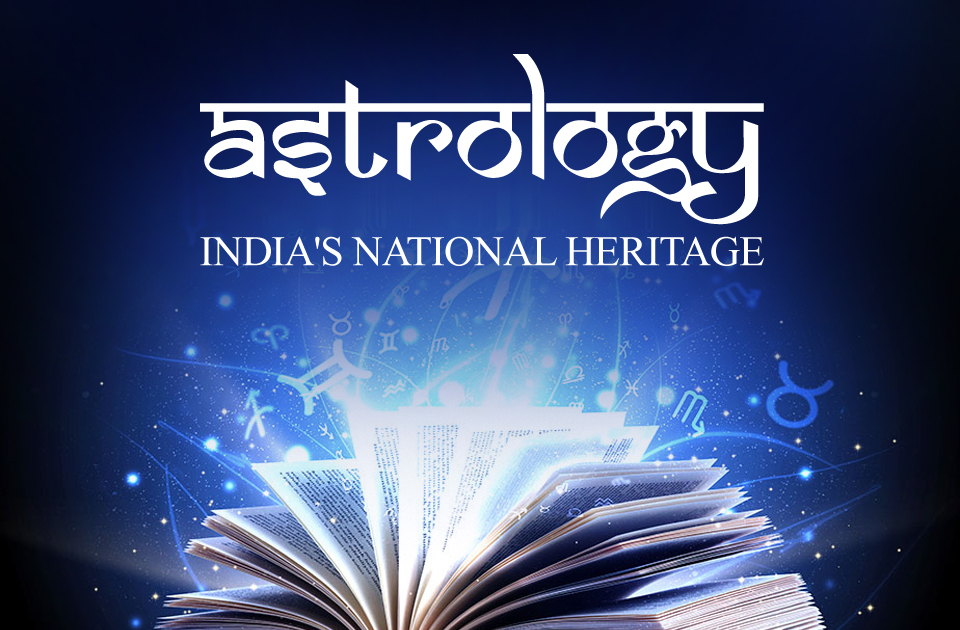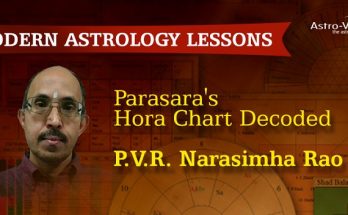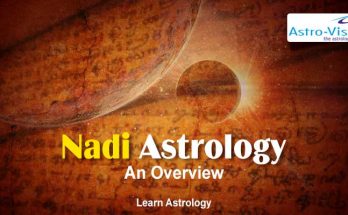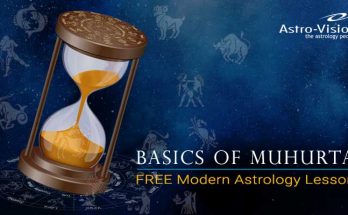Jyothisha is the science of light and light being radiation it is the science of radiation, of planetary and celestial radiation, and its impact on human affairs. Jyoti being light, Jyotisha can also be understood as the science which sheds light on areas of life to which you do not have access otherwise.
Astrology is also known as Kalavidana and Kalagnana or the science of time. It is the study of Kala Purusha, Time personified as the Zodiac. Astrology is the only science, even in the 21st century, which helps one understand the quality of time. Time, as we all know, is the canvas on which life flows. And life is nothing but a sequence or series of events or situations drawn on or latched on to the canvas of time. All creation begins, continues and finally dissolves in time. Take away time and the events have nowhere to stand upon. Creation itself would collapse. Therefore, time is the essence (substratum) of all existence. Time being so important, modern science so far has not even thought it fit to work at understanding its quality. It is only astrology that can do it through planetary movements and by tracing a pattern in them.
What was the quality of time on January 26, 2000 at about 8.00 a.m. in Bhuj in Gujarat when a devastating earthquake killed thousands of people? What was the quality of time on September 11, 2001 at about 9.30 a.m. in New York when the World Trade Centre was blasted by terrorists?
A critical examination of these moments will show you that they (whether at Bhuj or New York) were totally different from any other moments of the decade. These points of time had a unique quality about them – the quality’ of destruction on a massive scale.
The time at which the earthquake struck Bhuj, Saturn and Jupiter (2 major factors as defined in astrology) turned direct from retrograde motion within a period of 24 hours which is a rare celestial phenomenon. Mars and Rahu (two destructive explosive elements as defined in Jyotisha) were moving towards an exact opposition (13-9-2002) when diabolic violence rocked the American nation on September 11, 2001. What we see from these two cases is, how the quality of time is colored by planetary factors. Therefore, understanding the planetary movements and tracing a pattern in them which helps one understand the quality of time is what astrology is all about.
Jyotisha or Astrology has been a happening event of the last 100 years. A far reaching event of the 20th century, as important and in some ways more important than any other, was my father Dr. B. V. Raman’s crusade for astrology with its origins in our country but inundating western shores and engaging the attention of serious thinkers there. Dr. Raman’s name is today synonymous with astrology the world over. He strode the astrology scene for over 60 years like a colossus. He not only took astrology to the west and the rest of the world, more importantly, he revived and rejuvenated the science in the country of its origin creating new respect for it amongst the intelligentsia. If today, astrology is gaining momentum as a subject of serious academic pursuit, the credit should, in unequivocal terms go to Dr. Raman.
Jyotisha is often confused with newspaper forecasts by the majority of people. This is especially true of the present generation because they have no idea of its depth and profundity as well as its scientific foundations. They have never been properly introduced to Jyotisha.All ancient and classical works on astronomy are very clear in stating the content of Jyotisha.
Jyotisha or astrology comprises of three sections, namely (1) Siddanta, that is, Ganita or mathematics which includes Gola or spherical astronomy, (2) Samhita or mundane astrology which deals with planetary movements and their connection with natural terrestrial phenomena and lastly, (3) Hora or predictive astrology which deals with planetary positions and individual lives.
Varahamihira is acknowledged as one of the most outstanding exponents of Jyotisha after Parasara. He deals with the entire gamut of the subject in 3 brilliant masterpieces – Panchasiddhantika (Ganita), Brihat Samhita and Brihat Jataka (Hora) apart from several other works. Pancha Siddhantika is written as a Karanagrantha or a handbook for calculations in astronomy. Brihat Samhita deals with planetary motions and natural phenomena like weather, agriculture, earthquakes and collective destinies. Brihat Jataka deal with individual horoscopy. Varahamihira’s works may be deemed to be representative of the body of knowledge known as Jyotisha.
Varahamihira’s works are now being hailed by modern astronomers who also point to his scientific outlook. For instance, he gives details of prevailing practices relating to eclipses and dismisses them only as beliefs with no scientific basis. He then moves on to explain lunar and solar eclipses as astronomical phenomena and emphatically asserts: “the scientific fact is that Rahu (if understood as the demon) is not at all the cause of eclipses”.
Parameswara of Vatasreni (1360-1455) who preceded Copernicus by nearly 100 years is known to have revised the prevailing Parahita system of computation and evolved new methods in his work Drigganita. He is said to have made continuous observations for 55 years (with the help of instruments) of planetary conjunctions and eclipses before composing his Samadrigganitam about which his celebrated astronomer student Nilakanta Somayaji (1444-1545) pays glowing tributes:
Author of about 30 works, Parameswara has written 3 works on spherics – Goladipika I, II, III, Drigganitam, 3 works on improved computations and rationale of eclipses (Grahanashtaka, Grahana- mandana, Grahana-nyaya-deepika), a text on computation of the Moon’s shadow Chandracchaya Ganitam and rationale on the computation of mnemonic tables — Vakyakarana. He has written masterly commentaries on Aryabhatiyam, Mahabhaskariyam, Laghubhaskariyam and other astronomical treatises.
Parameswara’s approach, in fact, is representative of the ancient Indian astronomer’s methodology which consisted of prolonged and repeated observation, experimentation, recording of readings, checking of values obtained from observation with those obtained by computation and the postulation of samskaras (corrections) in order to make computations correspond with observations. He clearly says he had been observing eclipses from Saka 1315 (A.D. 1393), that he found that observed times to have always preceded the computed times and so the computations needed corrections.
Parameswara’s writings on astrology include Acharasangraha in two versions, one of them ending with Vivahanukula, Jataka Paddhati and Shadvargaphalam and commentaries on the Jatakarma- paddhati of Sripati, Prasnasatpanchasika of Prthuyasas, Muhurtashtaka (of an unknown author) and Muhurtaratna of Govinda Bhattathiri. In fact, the popular text of Parameswara, Jatakapaddhati, boasts of as many as 8 commentaries in Malayalam.
Most ancient astronomers were also master astrologers. Therefore, those who condemn astrology as superstition should stop to think before condemning the astrological works produced by these great intellects.
Astrology has seen phenomenal growth over the last six decades especially after Dr. Raman arrived on the scene. The application of astrology now includes such important areas as national and international developments, political affairs, earthquake prediction, volcanoes, cyclones, monsoons and weather prediction, public health, medical diagnosis and prognosis, surgery, accidents, aerial mishaps, marriage counselling, career counselling surgery etc., caesarean section births, test tube babies, IVF, AIDS and even terrorist attacks and many other topics of a contemporary nature which means astrology, though one of the oldest sciences known to mankind has been able to keep pace with changes in society.
Many astrology scholars are working privately and have gained new insights in the subject. The only difference between research in astrology and research in other sciences is that, the other sciences have Government funded backing, laboratory and other facilities and every other kind of support (which astrology does not have). Just for a moment, imagine if these sciences were not in the Universities, where would all the research activity of individual scientists go? It would die with the scientist. The same applies to astrology. Therefore it is important for all of us to work at introducing astrology into the Universities which will lead to training students in it and those interested could definitely pursue further study and research in the subject which can be coordinated by a central body and findings published and passed on to posterity.
Jyotisha rests on the Law of Karma and the Theory of Rebirth. Much before, thousands and thousands of years before Newton discovered the Laws of Motion that action and reaction are equal and opposite and that every body continues in its state of rest or of uniform motion unless acted upon by an external force, the Rishis or the great thinkers and intellectual giants of ancient India had clearly enunciated the law of action and reaction in a more comprehensive and complete sense extending its functioning to mental, moral, spiritual and ethical levels apart from the physical in what is commonly understood as the Law of Karma. The laws coming under Jyotisha assess the results of actions of past births in the form of the birth chart that each individual produces at birth.
The Karma Theory is often wrongly dismissed as encouraging fatalism but an objective approach to it will clearly show one that it brings in great accountability into all of one’s actions, thoughts and words.
Failed predictions are an important part of any attack against astrology. But failure of prediction cannot be a valid argument against astrology. Every science has its quota of failures. But here all the failures are swept under the carpet and only the rare correct one highlighted. Failure or success of prediction has nothing to do with a subject being science.
Just because space science has a long list of failures, would anyone dismiss space science as nonsense? Just because the patient dies during or after surgery which is a failure of medical science, do you condemn medical science as superstition? Just because a top class lawyer loses his case in the Supreme Court do you condemn jurisprudence as nonsense? Just because bridges and buildings built by engineers collapse, does engineering cease to be science? If not, then also astrology cannot be condemned because predictions go wrong. Why double intellectual and academic standards?
Each failure is only a stepping stone to a greater understanding of the nuances of any science, including Jyotisha. Failures should not be highlighted to throw stones at astrologers. But astrologers themselves should come together and look at the failure critically from the academic angle and try to see why it has gone wrong.
Caesarean section births are now the fashion. Many times, astrological help is sought for timing a caesarean section. When working out a Muhurta for the c-section, one must not attempt to create a birth chart for the baby that is due. When you look at the Muhurtam chart as the birth chart of the baby to be born, you are playing God. We, in the astrology community, must keep in mind that no one can play God and an astrologer should impress this on the consultee. The role of the Muhurta for a c-section is strictly confined to helping the surgical intervention proceed smoothly.
As in any other avocation, the astrologer too has a certain responsibility towards society and the people. Dr. Raman, who pioneered the study of astrology in a systemmatic manner, also worked to bring awareness in the astrological community of its responsibility towards society.
As the first step in this direction, the most important thing for an astrological savant in his interactions with society and its members, Dr. Raman would say, was to follow a code of conduct which is defined by Varahamihira, This code requires one proficient in astrology to be objective in his approach, well-versed in the theoretical texts of predictive and electional astrology, posses the gift of eloquence, persuasion and tact in one’s speech with an understanding of human psychology. One’s words should bring cheer and solace to those who come to one with problems. At the same time, one should be careful not to give exaggerated hopes to anyone.
Astrology is a science of indications and does not advocate fatalism. And as the sages say, Purushakarena vina (without human effort), daivam na siddyate (even the promised fortune cannot be attained). Astrology helps in understanding the direction in which effort should be made when such effort is to be made and also when it is to be given up.
Astrology is India’s priceless national heritage. It is ancient India’s gift to the world much like Vedanta. It helps one understand not only one’s potential for action but also the limits of such potential for that is the key to a stress-free life — stress being one of the most powerful epidemics that has hit mankind today.
Jyotisha is as relevant today as when it was first enunciated in ancient times. And looking at the strife and unhappiness around us, it is only Jyotisha that holds the key to alleviating human misery and contributing to Lok Kalyana. •
Courtesy: MODERN ASTROLOGY(Author :Mrs. Gayatri Devi Vasudev)










